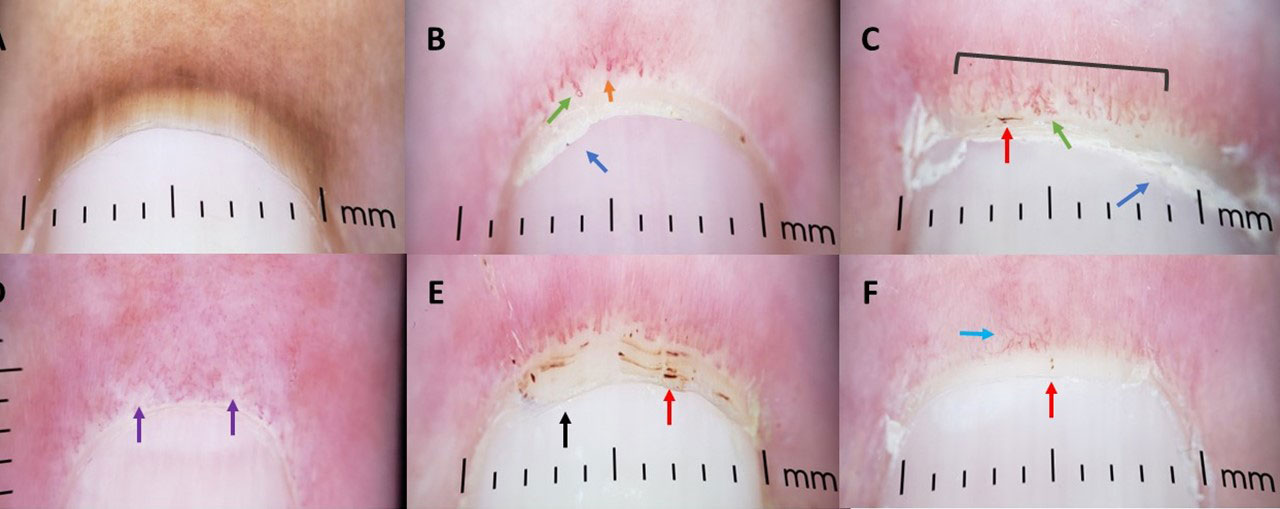Session Information
Session Type: Poster Session D
Session Time: 1:00PM-3:00PM
Background/Purpose: Nailfold capillary (NC) abnormalities are increasingly utilized in the evaluation of rheumatic conditions. Their presence can distinguish primary Raynaud’s phenomenon from secondary etiologies and are used in the diagnostic criteria of scleroderma. Dermoscopy is a convenient method of evaluating NC changes with similar efficacy to capillaroscopy. Literature pertaining to nailfold capillary changes in dermatomyositis (DM) commonly utilizes nailfold videocapillaroscopy to assess capillaries (200x magnification), which is not practical for clinical use. We aim to characterize nailfold capillary changes exhibited in dermatomyositis using a dermatoscope.
Methods: We imaged all ten nailfolds of subjects with dermatomyositis (DM) using a dermatoscope with a smartphone adapter. Fingernails were cleaned with an alcohol swab prior to evaluation. Subjects were included in they met ACR/EULAR criteria for DM or at the discretion of the principal investigator (VPW). Subjects with hypertension, hyperlipidemia, diabetes, glaucoma, or other primary rheumatic disease were excluded. Images were assessed for loop dilation, abnormal morphology, capillary bed disorganization, capillary hemorrhage, capillary dropout, decreased capillary density, subpapillary plexus visibility, cuticular dystrophy, and cuticular overgrowth (Figure 1). Cutaneous Dermatomyositis Area and Severity activity (CDASI-A) and damage (CDASI-D) scores were collected. Analysis used Student’s t-test and Chi-Squared test.
Results: 44 subjects, 17 with amyopathic DM (ADM), were included. Mean (standard error) CDASI activity and damage scores were 13 (1.05) and 4 (0.39), respectively. 89% of subjects demonstrated capillary abnormalities. Loop dilation (77%), followed by capillary bed disorganization (73%), were the two most common findings. NC changes were most often found on 4th and 5th fingers. Thumbs demonstrated the fewest abnormalities. Mean CDASI-A was higher in patients with abnormal morphology (CDASI 16 vs 10, p=0.003), capillary dropout (15 vs 10, p=0.016), decreased capillary density (17 vs 10, p< 0.001), and trended towards significance for loop dilation and capillary bed disorganization. There was a trend towards a higher percentage of capillary hemorrhage in patients with ADM compared to those with muscle disease (no difference in CDASI-A). Subjects with skin limited disease (n=23) vs active systemic disease demonstrated more abnormal morphology (74% vs 38%, p=0.02; no difference in CDASI-A).
Conclusion: Given their prevalence, dermatoscopic evaluation of nailfold capillary changes may be useful for the diagnosis of DM. Loop dilation and capillary bed disorganization are the two most common nailfold capillary changes in DM. Changes are most commonly found on the 4th and 5th digits. Abnormal morphology, capillary dropout, and decreased capillary correlate with cutaneous disease activity.
To cite this abstract in AMA style:
Dan J, Sprow G, Concha J, Kodali N, Diaz D, Chin F, Vazquez T, Werth V. Characterizing Nailfold Capillary Changes in Dermatomyositis with a Dermatoscope [abstract]. Arthritis Rheumatol. 2022; 74 (suppl 9). https://acrabstracts.org/abstract/characterizing-nailfold-capillary-changes-in-dermatomyositis-with-a-dermatoscope/. Accessed .« Back to ACR Convergence 2022
ACR Meeting Abstracts - https://acrabstracts.org/abstract/characterizing-nailfold-capillary-changes-in-dermatomyositis-with-a-dermatoscope/

